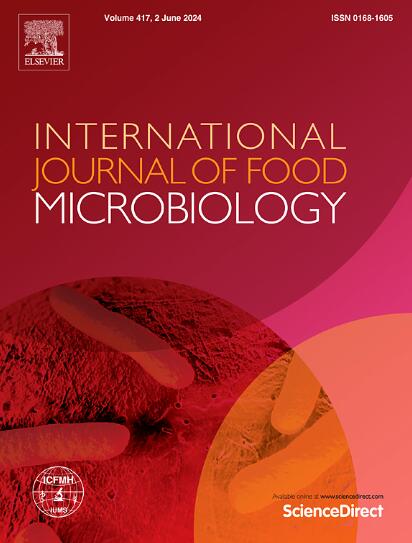Two novel Vibrio parahaemolyticus phages (vB_VpaS_1601 and vB_VpaP_1701) can serve as potential biocontrol agents against Vibrio parahaemolyticus infection in seafood
IF 5
1区 农林科学
Q1 FOOD SCIENCE & TECHNOLOGY
International journal of food microbiology
Pub Date : 2025-06-04
DOI:10.1016/j.ijfoodmicro.2025.111303
引用次数: 0
Abstract
Vibrio parahaemolyticus poses a serious threat to the aquaculture industry and human health. Two novel phages (vB_VpaS_1601 and vB_VpaP_1701) were isolated from oysters. Phage vB_VpaS_1601 and phage vB_VpaP_1701 exhibited short latent periods and high burst sizes. In addition, both phages showed stability across a broad range of temperature and pH conditions. Genomic analyses revealed that phage vB_VpaS_1601 is a novel genus of the Caudoviricetes class, and vB_VpaP_1701 is a new species of the Maculvirus genus, Autographiviridae family. Both single phage and phage cocktail can inhibit V. parahaemolyticus proliferation, with phage cocktail (MOI = 1) can completely inhibit the growth of V. parahaemolyticus within 12 h. The phages reduced biofilm formation by 53.57 % (vB_VpaS_1601) and 64.88 % (vB_VpaP_1701), while the cocktail achieved 46 %–78 % inhibition. Phage cocktail can reduce V. parahaemolyticus by 1.53–2.74 log CFU/cm3 in salmon and 1.56–2.91 log CFU/cm3 in oysters. These results indicated that vB_VpaS_1601 and vB_VpaP_1701 have potential as antibacterial agents for controlling V. parahaemolyticus in seafood products.
两种新型副溶血性弧菌噬菌体vB_VpaS_1601和vB_VpaP_1701可作为潜在的海产品副溶血性弧菌生物防治剂
副溶血性弧菌对水产养殖业和人类健康构成严重威胁。从牡蛎中分离到两个新的噬菌体vB_VpaS_1601和vB_VpaP_1701。噬菌体vB_VpaS_1601和vB_VpaP_1701潜伏期短,爆发量大。此外,两种噬菌体在广泛的温度和pH条件下都表现出稳定性。基因组分析表明,噬菌体vb_vpap_1601是尾状病毒纲的新属,vB_VpaP_1701是自噬病毒科Maculvirus属的新种。单噬菌体和鸡尾酒噬菌体均能抑制副溶血性弧菌的增殖,其中鸡尾酒噬菌体(MOI = 1)能在12 h内完全抑制副溶血性弧菌的生长,噬菌体使生物膜的形成减少53.57% (vB_VpaS_1601)和64.88% (vB_VpaP_1701),而鸡尾酒噬菌体的抑制率为46% - 78%。噬菌体鸡尾酒可使鲑鱼和牡蛎的副溶血性弧菌分别减少1.53-2.74 log CFU/cm3和1.56-2.91 log CFU/cm3。结果表明,vB_VpaS_1601和vB_VpaP_1701具有作为控制海产品副溶血性弧菌的抑菌剂的潜力。
本文章由计算机程序翻译,如有差异,请以英文原文为准。
求助全文
约1分钟内获得全文
求助全文
来源期刊
CiteScore
10.40
自引率
5.60%
发文量
322
审稿时长
65 days
期刊介绍:
The International Journal of Food Microbiology publishes papers dealing with all aspects of food microbiology. Articles must present information that is novel, has high impact and interest, and is of high scientific quality. They should provide scientific or technological advancement in the specific field of interest of the journal and enhance its strong international reputation. Preliminary or confirmatory results as well as contributions not strictly related to food microbiology will not be considered for publication.

 求助内容:
求助内容: 应助结果提醒方式:
应助结果提醒方式:


